Global Broadband Access: A Detailed Report on the Australian NBN Plan
VerifiedAdded on 2021/05/31
|8
|1716
|54
Report
AI Summary
This report provides a comprehensive analysis of global broadband access, with a specific focus on the Australian National Broadband Plan (NBN). It begins with an executive summary and introduction, outlining the report's objectives. The report then delves into the national broadband infrastructure initiatives, detailing the current status of the NBN and presenting relevant data on internet speeds and monthly broadband plans in Australia. The 'digital divide' within Australia is discussed, exploring the factors contributing to digital inequality. The report identifies countries with the lowest broadband rates and examines the associated costs. The benefits of high broadband access connections, such as reliability, security, and cost-effectiveness, are also highlighted. The report concludes with a summary of key findings and references supporting the analysis. The research includes data on the NBN rollout, household internet usage, and comparisons of broadband costs across different countries, providing a detailed overview of the broadband landscape.
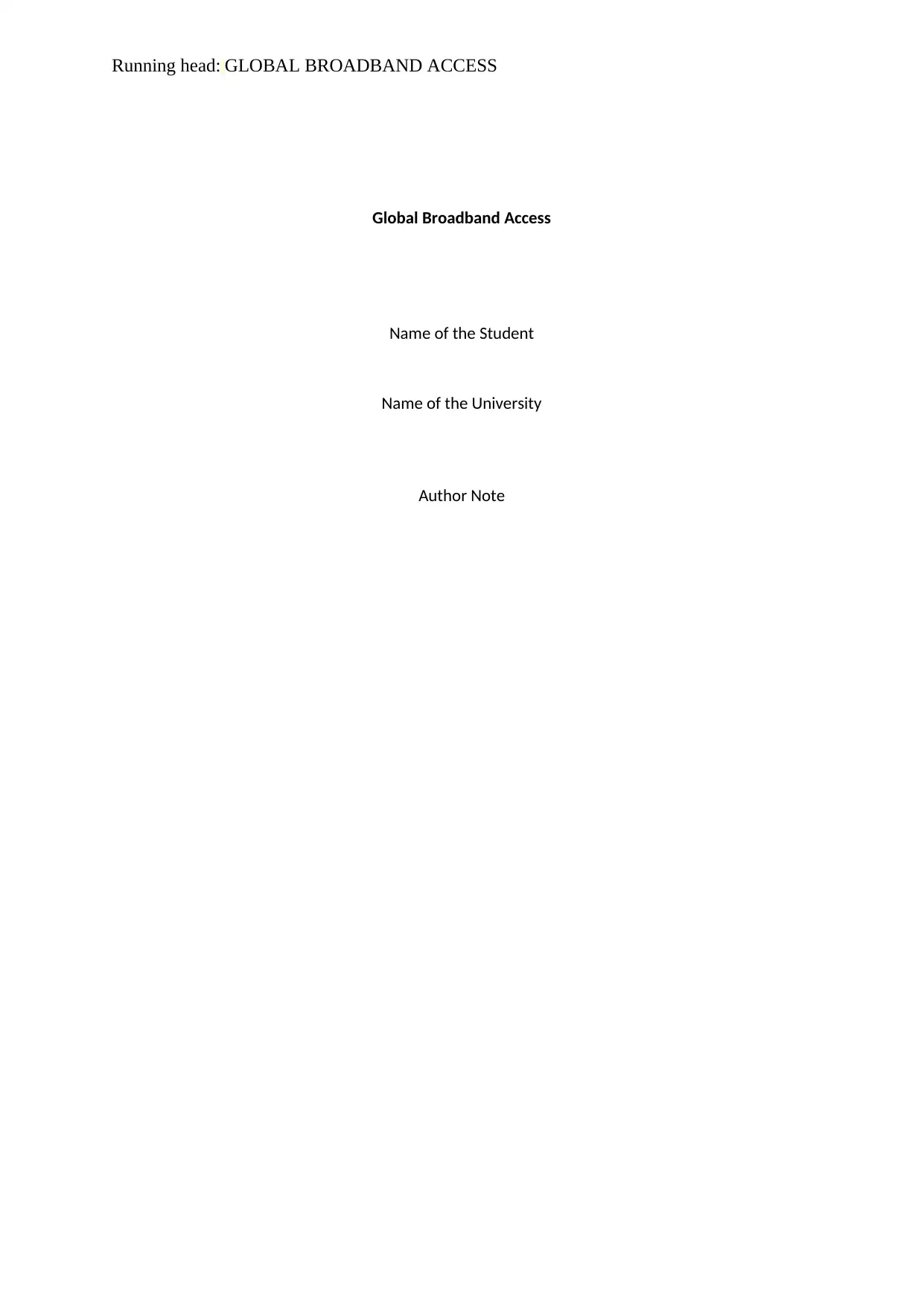
Running head: GLOBAL BROADBAND ACCESS
Global Broadband Access
Name of the Student
Name of the University
Author Note
Global Broadband Access
Name of the Student
Name of the University
Author Note
Paraphrase This Document
Need a fresh take? Get an instant paraphrase of this document with our AI Paraphraser

1GLOBAL BROADBAND ACCESS
Executive Summary:
In this report the case study of Australian National Broadband will be discuss in detail provided
relevant data and information about the use of internet access in Australia and other parts of the
world. A strong and logical evidence will be provided based on the research done on the countries
broadband plan and infrastructure. Finally, conclude with a proper brief summary about the whole
report.
Executive Summary:
In this report the case study of Australian National Broadband will be discuss in detail provided
relevant data and information about the use of internet access in Australia and other parts of the
world. A strong and logical evidence will be provided based on the research done on the countries
broadband plan and infrastructure. Finally, conclude with a proper brief summary about the whole
report.
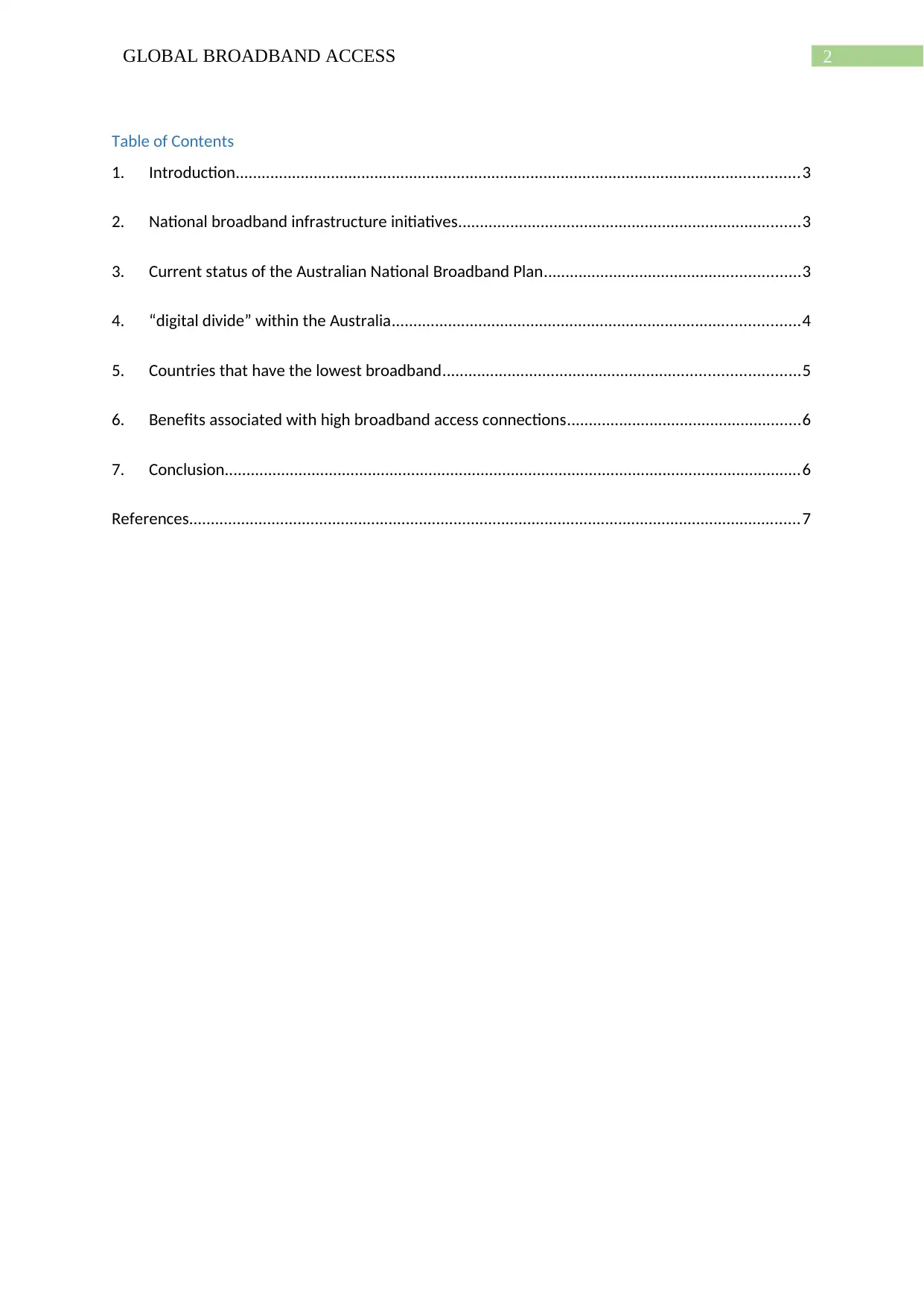
2GLOBAL BROADBAND ACCESS
Table of Contents
1. Introduction..................................................................................................................................3
2. National broadband infrastructure initiatives...............................................................................3
3. Current status of the Australian National Broadband Plan...........................................................3
4. “digital divide” within the Australia..............................................................................................4
5. Countries that have the lowest broadband..................................................................................5
6. Benefits associated with high broadband access connections......................................................6
7. Conclusion.....................................................................................................................................6
References.............................................................................................................................................7
Table of Contents
1. Introduction..................................................................................................................................3
2. National broadband infrastructure initiatives...............................................................................3
3. Current status of the Australian National Broadband Plan...........................................................3
4. “digital divide” within the Australia..............................................................................................4
5. Countries that have the lowest broadband..................................................................................5
6. Benefits associated with high broadband access connections......................................................6
7. Conclusion.....................................................................................................................................6
References.............................................................................................................................................7
⊘ This is a preview!⊘
Do you want full access?
Subscribe today to unlock all pages.

Trusted by 1+ million students worldwide
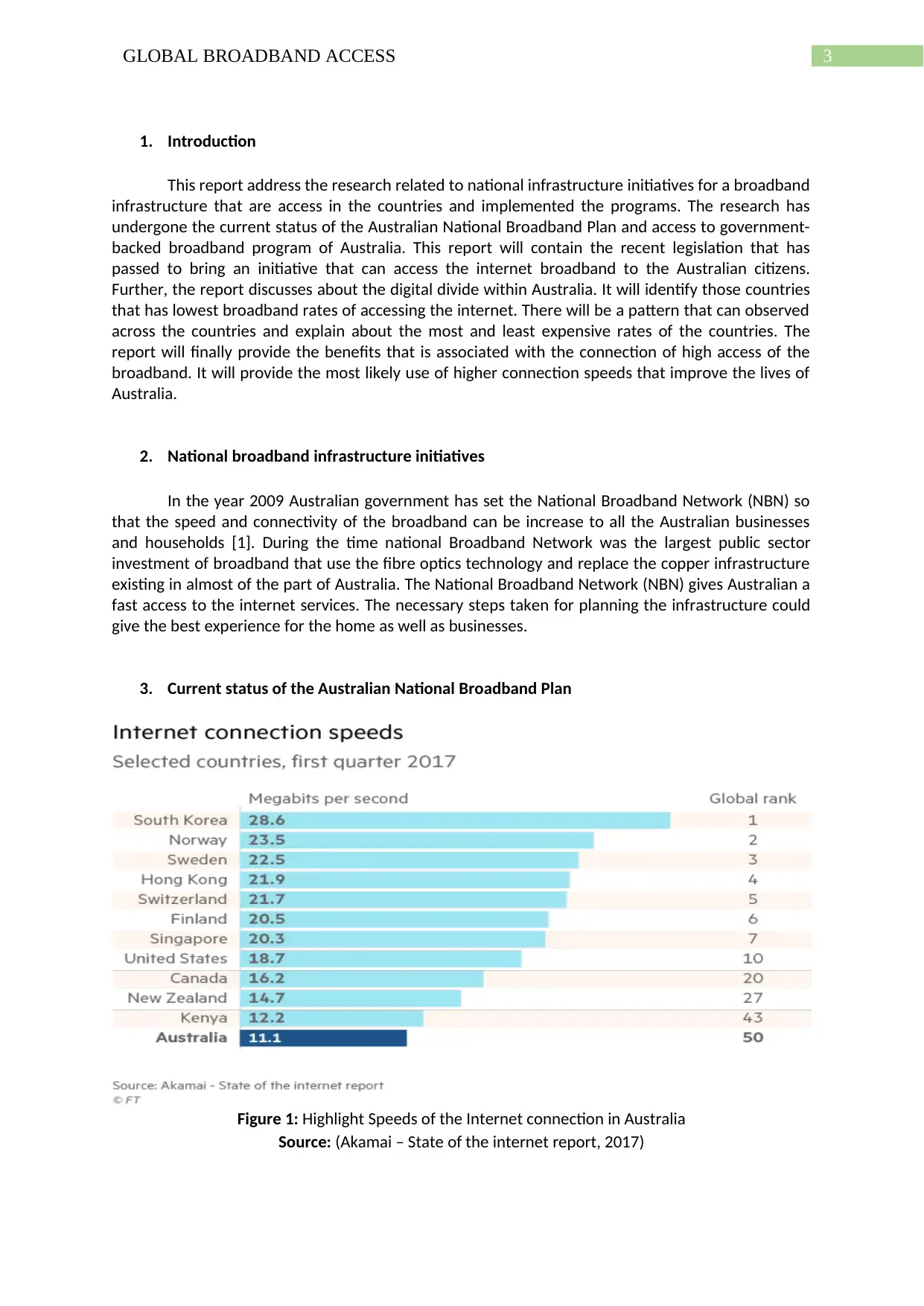
3GLOBAL BROADBAND ACCESS
1. Introduction
This report address the research related to national infrastructure initiatives for a broadband
infrastructure that are access in the countries and implemented the programs. The research has
undergone the current status of the Australian National Broadband Plan and access to government-
backed broadband program of Australia. This report will contain the recent legislation that has
passed to bring an initiative that can access the internet broadband to the Australian citizens.
Further, the report discusses about the digital divide within Australia. It will identify those countries
that has lowest broadband rates of accessing the internet. There will be a pattern that can observed
across the countries and explain about the most and least expensive rates of the countries. The
report will finally provide the benefits that is associated with the connection of high access of the
broadband. It will provide the most likely use of higher connection speeds that improve the lives of
Australia.
2. National broadband infrastructure initiatives
In the year 2009 Australian government has set the National Broadband Network (NBN) so
that the speed and connectivity of the broadband can be increase to all the Australian businesses
and households [1]. During the time national Broadband Network was the largest public sector
investment of broadband that use the fibre optics technology and replace the copper infrastructure
existing in almost of the part of Australia. The National Broadband Network (NBN) gives Australian a
fast access to the internet services. The necessary steps taken for planning the infrastructure could
give the best experience for the home as well as businesses.
3. Current status of the Australian National Broadband Plan
Figure 1: Highlight Speeds of the Internet connection in Australia
Source: (Akamai – State of the internet report, 2017)
1. Introduction
This report address the research related to national infrastructure initiatives for a broadband
infrastructure that are access in the countries and implemented the programs. The research has
undergone the current status of the Australian National Broadband Plan and access to government-
backed broadband program of Australia. This report will contain the recent legislation that has
passed to bring an initiative that can access the internet broadband to the Australian citizens.
Further, the report discusses about the digital divide within Australia. It will identify those countries
that has lowest broadband rates of accessing the internet. There will be a pattern that can observed
across the countries and explain about the most and least expensive rates of the countries. The
report will finally provide the benefits that is associated with the connection of high access of the
broadband. It will provide the most likely use of higher connection speeds that improve the lives of
Australia.
2. National broadband infrastructure initiatives
In the year 2009 Australian government has set the National Broadband Network (NBN) so
that the speed and connectivity of the broadband can be increase to all the Australian businesses
and households [1]. During the time national Broadband Network was the largest public sector
investment of broadband that use the fibre optics technology and replace the copper infrastructure
existing in almost of the part of Australia. The National Broadband Network (NBN) gives Australian a
fast access to the internet services. The necessary steps taken for planning the infrastructure could
give the best experience for the home as well as businesses.
3. Current status of the Australian National Broadband Plan
Figure 1: Highlight Speeds of the Internet connection in Australia
Source: (Akamai – State of the internet report, 2017)
Paraphrase This Document
Need a fresh take? Get an instant paraphrase of this document with our AI Paraphraser
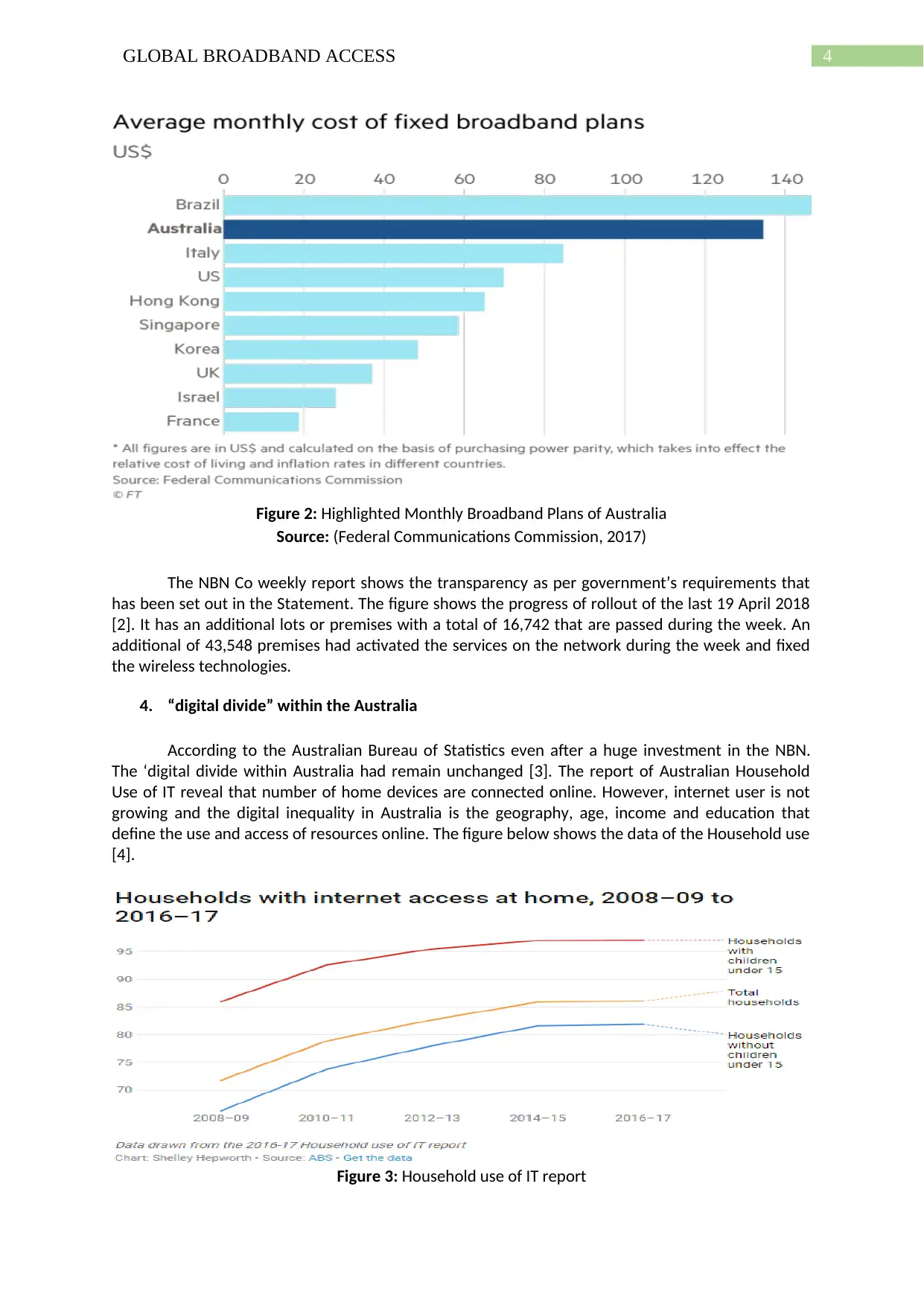
4GLOBAL BROADBAND ACCESS
Figure 2: Highlighted Monthly Broadband Plans of Australia
Source: (Federal Communications Commission, 2017)
The NBN Co weekly report shows the transparency as per government’s requirements that
has been set out in the Statement. The figure shows the progress of rollout of the last 19 April 2018
[2]. It has an additional lots or premises with a total of 16,742 that are passed during the week. An
additional of 43,548 premises had activated the services on the network during the week and fixed
the wireless technologies.
4. “digital divide” within the Australia
According to the Australian Bureau of Statistics even after a huge investment in the NBN.
The ‘digital divide within Australia had remain unchanged [3]. The report of Australian Household
Use of IT reveal that number of home devices are connected online. However, internet user is not
growing and the digital inequality in Australia is the geography, age, income and education that
define the use and access of resources online. The figure below shows the data of the Household use
[4].
Figure 3: Household use of IT report
Figure 2: Highlighted Monthly Broadband Plans of Australia
Source: (Federal Communications Commission, 2017)
The NBN Co weekly report shows the transparency as per government’s requirements that
has been set out in the Statement. The figure shows the progress of rollout of the last 19 April 2018
[2]. It has an additional lots or premises with a total of 16,742 that are passed during the week. An
additional of 43,548 premises had activated the services on the network during the week and fixed
the wireless technologies.
4. “digital divide” within the Australia
According to the Australian Bureau of Statistics even after a huge investment in the NBN.
The ‘digital divide within Australia had remain unchanged [3]. The report of Australian Household
Use of IT reveal that number of home devices are connected online. However, internet user is not
growing and the digital inequality in Australia is the geography, age, income and education that
define the use and access of resources online. The figure below shows the data of the Household use
[4].
Figure 3: Household use of IT report
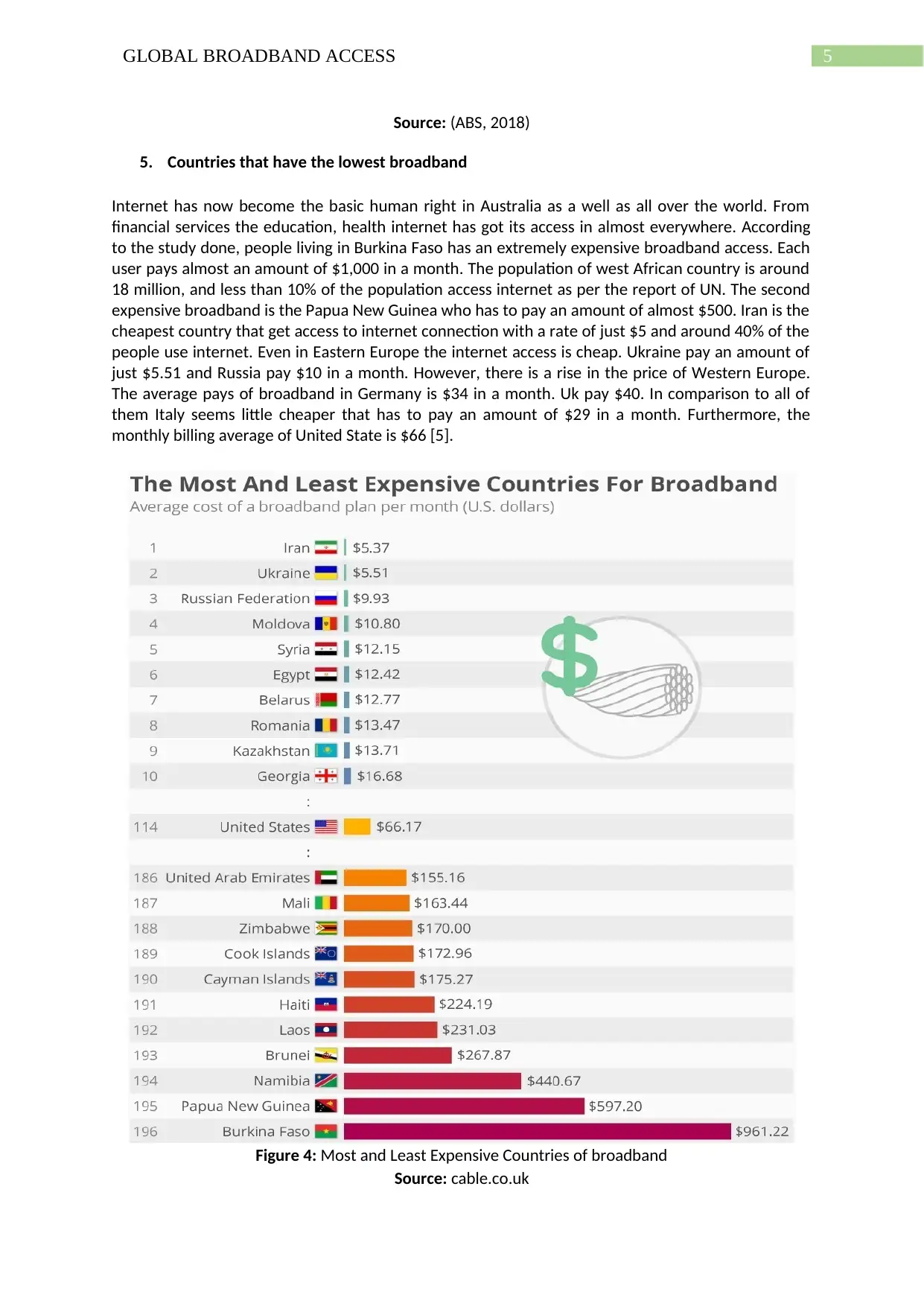
5GLOBAL BROADBAND ACCESS
Source: (ABS, 2018)
5. Countries that have the lowest broadband
Internet has now become the basic human right in Australia as a well as all over the world. From
financial services the education, health internet has got its access in almost everywhere. According
to the study done, people living in Burkina Faso has an extremely expensive broadband access. Each
user pays almost an amount of $1,000 in a month. The population of west African country is around
18 million, and less than 10% of the population access internet as per the report of UN. The second
expensive broadband is the Papua New Guinea who has to pay an amount of almost $500. Iran is the
cheapest country that get access to internet connection with a rate of just $5 and around 40% of the
people use internet. Even in Eastern Europe the internet access is cheap. Ukraine pay an amount of
just $5.51 and Russia pay $10 in a month. However, there is a rise in the price of Western Europe.
The average pays of broadband in Germany is $34 in a month. Uk pay $40. In comparison to all of
them Italy seems little cheaper that has to pay an amount of $29 in a month. Furthermore, the
monthly billing average of United State is $66 [5].
Figure 4: Most and Least Expensive Countries of broadband
Source: cable.co.uk
Source: (ABS, 2018)
5. Countries that have the lowest broadband
Internet has now become the basic human right in Australia as a well as all over the world. From
financial services the education, health internet has got its access in almost everywhere. According
to the study done, people living in Burkina Faso has an extremely expensive broadband access. Each
user pays almost an amount of $1,000 in a month. The population of west African country is around
18 million, and less than 10% of the population access internet as per the report of UN. The second
expensive broadband is the Papua New Guinea who has to pay an amount of almost $500. Iran is the
cheapest country that get access to internet connection with a rate of just $5 and around 40% of the
people use internet. Even in Eastern Europe the internet access is cheap. Ukraine pay an amount of
just $5.51 and Russia pay $10 in a month. However, there is a rise in the price of Western Europe.
The average pays of broadband in Germany is $34 in a month. Uk pay $40. In comparison to all of
them Italy seems little cheaper that has to pay an amount of $29 in a month. Furthermore, the
monthly billing average of United State is $66 [5].
Figure 4: Most and Least Expensive Countries of broadband
Source: cable.co.uk
⊘ This is a preview!⊘
Do you want full access?
Subscribe today to unlock all pages.

Trusted by 1+ million students worldwide
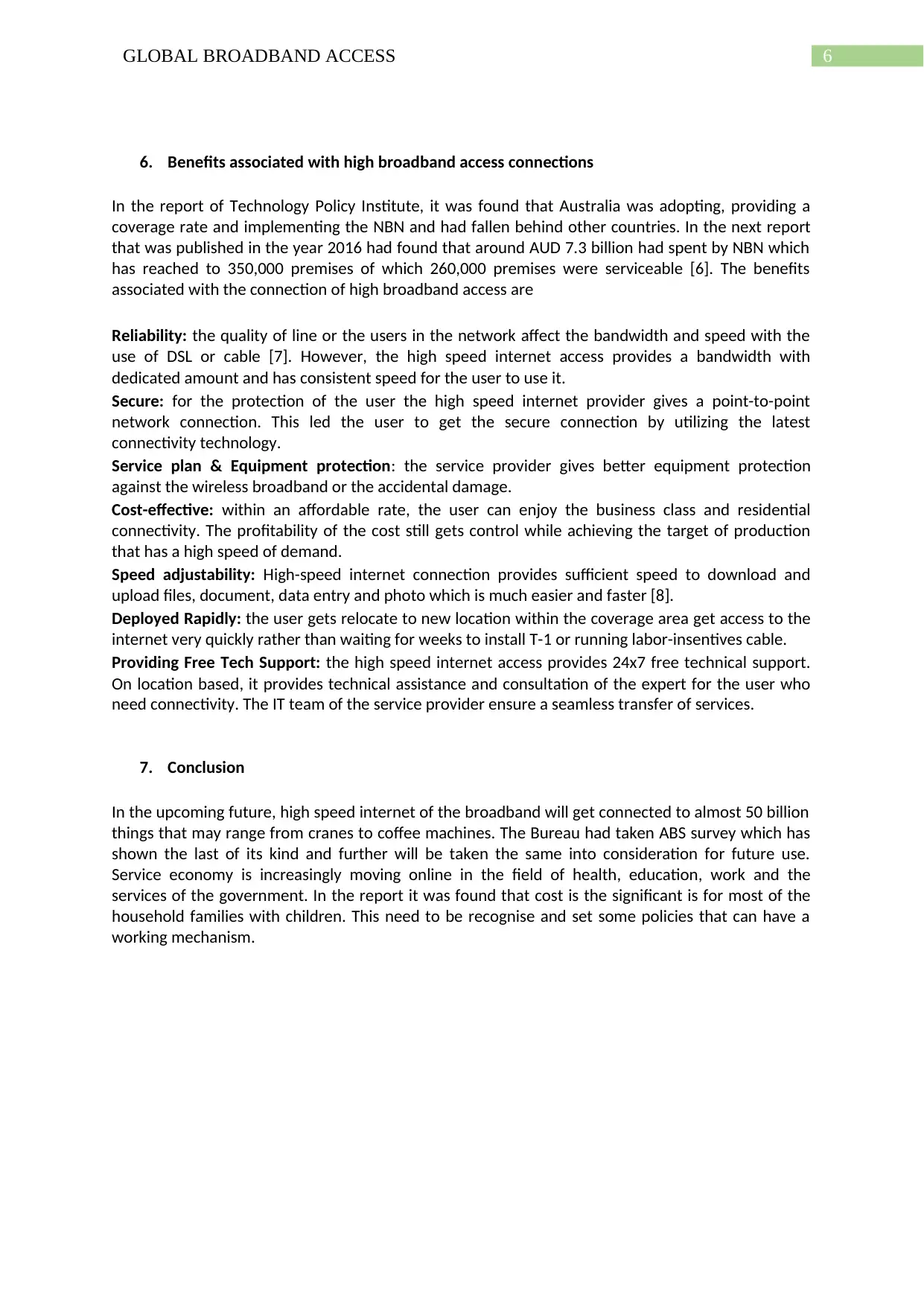
6GLOBAL BROADBAND ACCESS
6. Benefits associated with high broadband access connections
In the report of Technology Policy Institute, it was found that Australia was adopting, providing a
coverage rate and implementing the NBN and had fallen behind other countries. In the next report
that was published in the year 2016 had found that around AUD 7.3 billion had spent by NBN which
has reached to 350,000 premises of which 260,000 premises were serviceable [6]. The benefits
associated with the connection of high broadband access are
Reliability: the quality of line or the users in the network affect the bandwidth and speed with the
use of DSL or cable [7]. However, the high speed internet access provides a bandwidth with
dedicated amount and has consistent speed for the user to use it.
Secure: for the protection of the user the high speed internet provider gives a point-to-point
network connection. This led the user to get the secure connection by utilizing the latest
connectivity technology.
Service plan & Equipment protection: the service provider gives better equipment protection
against the wireless broadband or the accidental damage.
Cost-effective: within an affordable rate, the user can enjoy the business class and residential
connectivity. The profitability of the cost still gets control while achieving the target of production
that has a high speed of demand.
Speed adjustability: High-speed internet connection provides sufficient speed to download and
upload files, document, data entry and photo which is much easier and faster [8].
Deployed Rapidly: the user gets relocate to new location within the coverage area get access to the
internet very quickly rather than waiting for weeks to install T-1 or running labor-insentives cable.
Providing Free Tech Support: the high speed internet access provides 24x7 free technical support.
On location based, it provides technical assistance and consultation of the expert for the user who
need connectivity. The IT team of the service provider ensure a seamless transfer of services.
7. Conclusion
In the upcoming future, high speed internet of the broadband will get connected to almost 50 billion
things that may range from cranes to coffee machines. The Bureau had taken ABS survey which has
shown the last of its kind and further will be taken the same into consideration for future use.
Service economy is increasingly moving online in the field of health, education, work and the
services of the government. In the report it was found that cost is the significant is for most of the
household families with children. This need to be recognise and set some policies that can have a
working mechanism.
6. Benefits associated with high broadband access connections
In the report of Technology Policy Institute, it was found that Australia was adopting, providing a
coverage rate and implementing the NBN and had fallen behind other countries. In the next report
that was published in the year 2016 had found that around AUD 7.3 billion had spent by NBN which
has reached to 350,000 premises of which 260,000 premises were serviceable [6]. The benefits
associated with the connection of high broadband access are
Reliability: the quality of line or the users in the network affect the bandwidth and speed with the
use of DSL or cable [7]. However, the high speed internet access provides a bandwidth with
dedicated amount and has consistent speed for the user to use it.
Secure: for the protection of the user the high speed internet provider gives a point-to-point
network connection. This led the user to get the secure connection by utilizing the latest
connectivity technology.
Service plan & Equipment protection: the service provider gives better equipment protection
against the wireless broadband or the accidental damage.
Cost-effective: within an affordable rate, the user can enjoy the business class and residential
connectivity. The profitability of the cost still gets control while achieving the target of production
that has a high speed of demand.
Speed adjustability: High-speed internet connection provides sufficient speed to download and
upload files, document, data entry and photo which is much easier and faster [8].
Deployed Rapidly: the user gets relocate to new location within the coverage area get access to the
internet very quickly rather than waiting for weeks to install T-1 or running labor-insentives cable.
Providing Free Tech Support: the high speed internet access provides 24x7 free technical support.
On location based, it provides technical assistance and consultation of the expert for the user who
need connectivity. The IT team of the service provider ensure a seamless transfer of services.
7. Conclusion
In the upcoming future, high speed internet of the broadband will get connected to almost 50 billion
things that may range from cranes to coffee machines. The Bureau had taken ABS survey which has
shown the last of its kind and further will be taken the same into consideration for future use.
Service economy is increasingly moving online in the field of health, education, work and the
services of the government. In the report it was found that cost is the significant is for most of the
household families with children. This need to be recognise and set some policies that can have a
working mechanism.
Paraphrase This Document
Need a fresh take? Get an instant paraphrase of this document with our AI Paraphraser
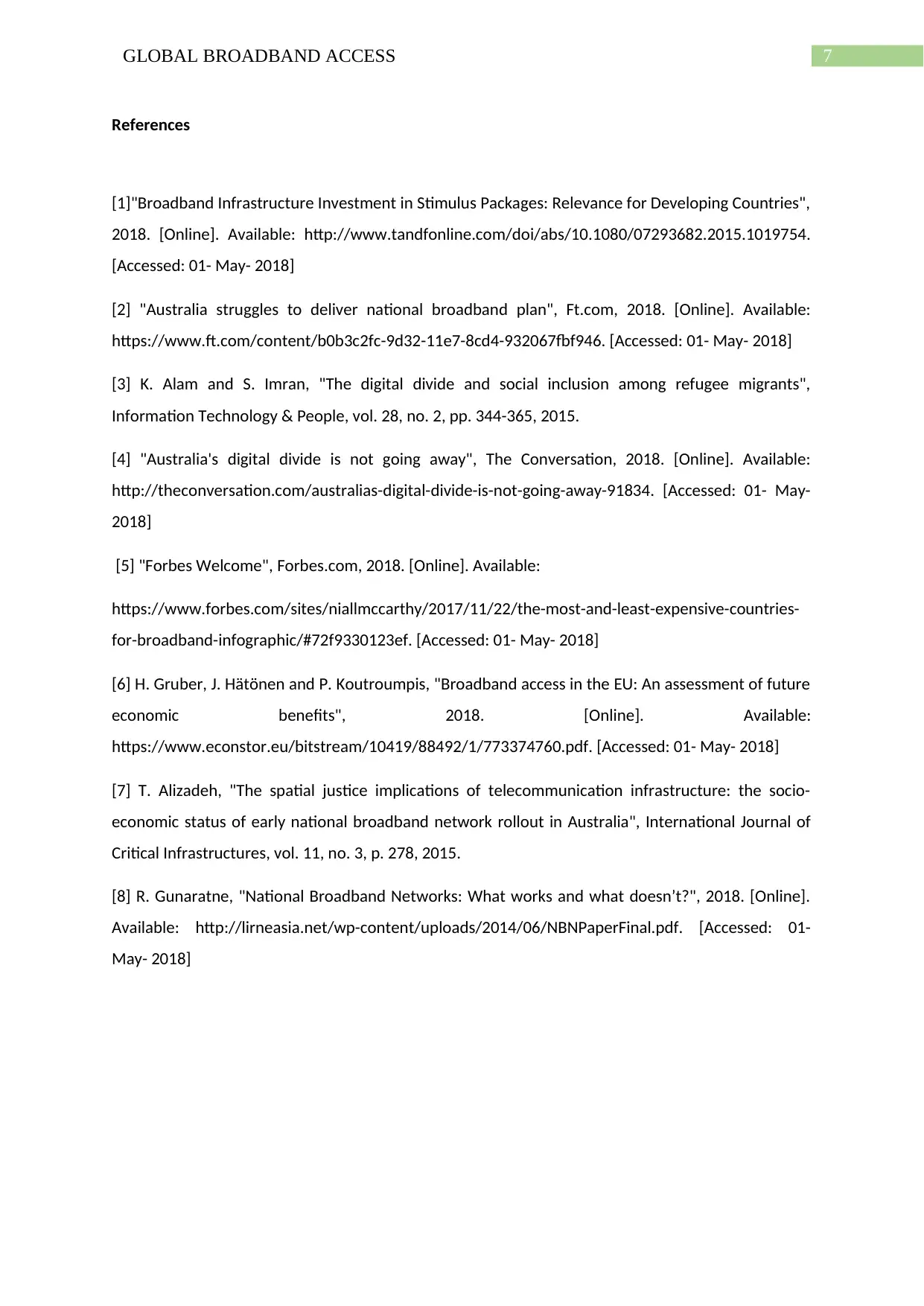
7GLOBAL BROADBAND ACCESS
References
[1]"Broadband Infrastructure Investment in Stimulus Packages: Relevance for Developing Countries",
2018. [Online]. Available: http://www.tandfonline.com/doi/abs/10.1080/07293682.2015.1019754.
[Accessed: 01- May- 2018]
[2] "Australia struggles to deliver national broadband plan", Ft.com, 2018. [Online]. Available:
https://www.ft.com/content/b0b3c2fc-9d32-11e7-8cd4-932067fbf946. [Accessed: 01- May- 2018]
[3] K. Alam and S. Imran, "The digital divide and social inclusion among refugee migrants",
Information Technology & People, vol. 28, no. 2, pp. 344-365, 2015.
[4] "Australia's digital divide is not going away", The Conversation, 2018. [Online]. Available:
http://theconversation.com/australias-digital-divide-is-not-going-away-91834. [Accessed: 01- May-
2018]
[5] "Forbes Welcome", Forbes.com, 2018. [Online]. Available:
https://www.forbes.com/sites/niallmccarthy/2017/11/22/the-most-and-least-expensive-countries-
for-broadband-infographic/#72f9330123ef. [Accessed: 01- May- 2018]
[6] H. Gruber, J. Hätönen and P. Koutroumpis, "Broadband access in the EU: An assessment of future
economic benefits", 2018. [Online]. Available:
https://www.econstor.eu/bitstream/10419/88492/1/773374760.pdf. [Accessed: 01- May- 2018]
[7] T. Alizadeh, "The spatial justice implications of telecommunication infrastructure: the socio-
economic status of early national broadband network rollout in Australia", International Journal of
Critical Infrastructures, vol. 11, no. 3, p. 278, 2015.
[8] R. Gunaratne, "National Broadband Networks: What works and what doesn’t?", 2018. [Online].
Available: http://lirneasia.net/wp-content/uploads/2014/06/NBNPaperFinal.pdf. [Accessed: 01-
May- 2018]
References
[1]"Broadband Infrastructure Investment in Stimulus Packages: Relevance for Developing Countries",
2018. [Online]. Available: http://www.tandfonline.com/doi/abs/10.1080/07293682.2015.1019754.
[Accessed: 01- May- 2018]
[2] "Australia struggles to deliver national broadband plan", Ft.com, 2018. [Online]. Available:
https://www.ft.com/content/b0b3c2fc-9d32-11e7-8cd4-932067fbf946. [Accessed: 01- May- 2018]
[3] K. Alam and S. Imran, "The digital divide and social inclusion among refugee migrants",
Information Technology & People, vol. 28, no. 2, pp. 344-365, 2015.
[4] "Australia's digital divide is not going away", The Conversation, 2018. [Online]. Available:
http://theconversation.com/australias-digital-divide-is-not-going-away-91834. [Accessed: 01- May-
2018]
[5] "Forbes Welcome", Forbes.com, 2018. [Online]. Available:
https://www.forbes.com/sites/niallmccarthy/2017/11/22/the-most-and-least-expensive-countries-
for-broadband-infographic/#72f9330123ef. [Accessed: 01- May- 2018]
[6] H. Gruber, J. Hätönen and P. Koutroumpis, "Broadband access in the EU: An assessment of future
economic benefits", 2018. [Online]. Available:
https://www.econstor.eu/bitstream/10419/88492/1/773374760.pdf. [Accessed: 01- May- 2018]
[7] T. Alizadeh, "The spatial justice implications of telecommunication infrastructure: the socio-
economic status of early national broadband network rollout in Australia", International Journal of
Critical Infrastructures, vol. 11, no. 3, p. 278, 2015.
[8] R. Gunaratne, "National Broadband Networks: What works and what doesn’t?", 2018. [Online].
Available: http://lirneasia.net/wp-content/uploads/2014/06/NBNPaperFinal.pdf. [Accessed: 01-
May- 2018]
1 out of 8
Related Documents
Your All-in-One AI-Powered Toolkit for Academic Success.
+13062052269
info@desklib.com
Available 24*7 on WhatsApp / Email
![[object Object]](/_next/static/media/star-bottom.7253800d.svg)
Unlock your academic potential
Copyright © 2020–2025 A2Z Services. All Rights Reserved. Developed and managed by ZUCOL.





